(新课标) Unit 10 I'd like some noodles. Section A Grammar focus-3c语法课示范课课件(共34张)
文档属性
| 名称 | (新课标) Unit 10 I'd like some noodles. Section A Grammar focus-3c语法课示范课课件(共34张) | 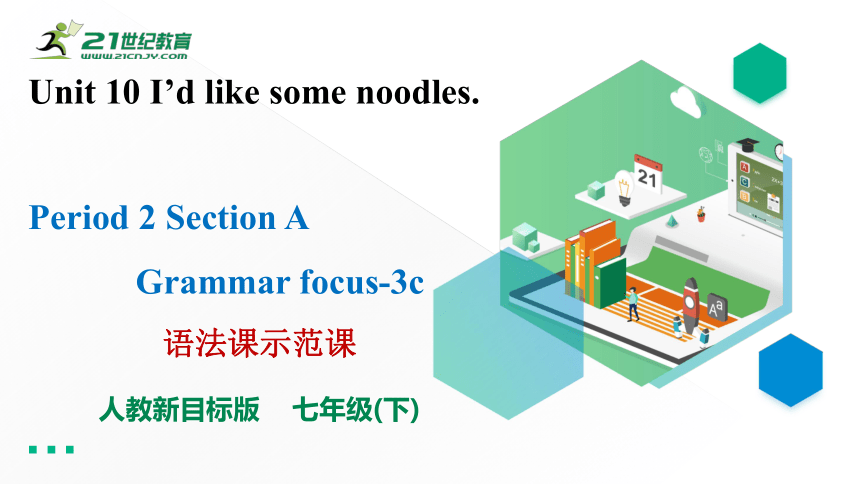 | |
| 格式 | ppt | ||
| 文件大小 | 8.9MB | ||
| 资源类型 | 试卷 | ||
| 版本资源 | 人教新目标(Go for it)版 | ||
| 科目 | 英语 | ||
| 更新时间 | 2023-05-11 14:20:50 | ||
图片预览


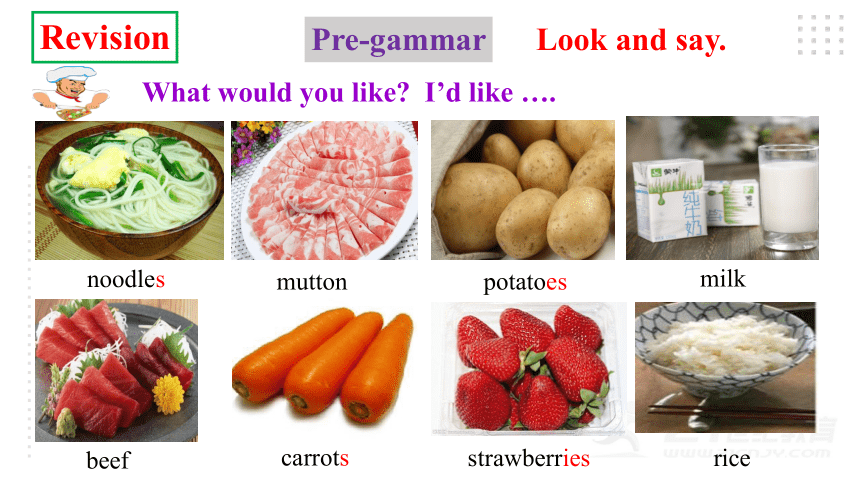
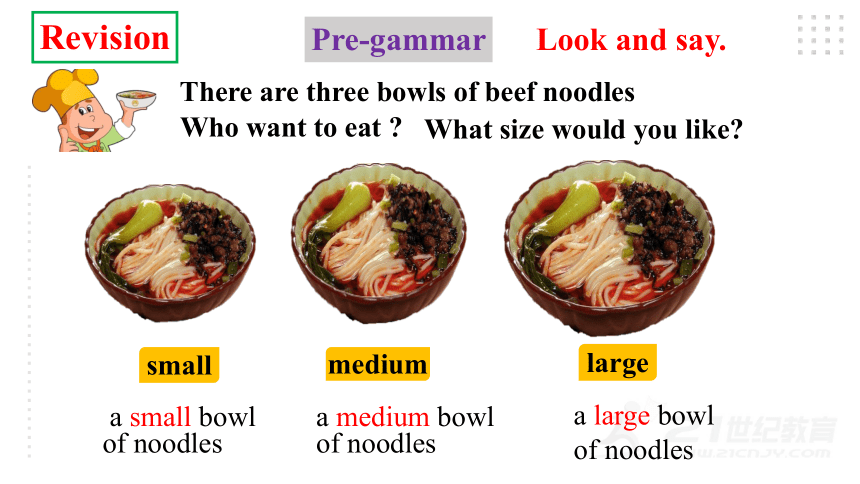
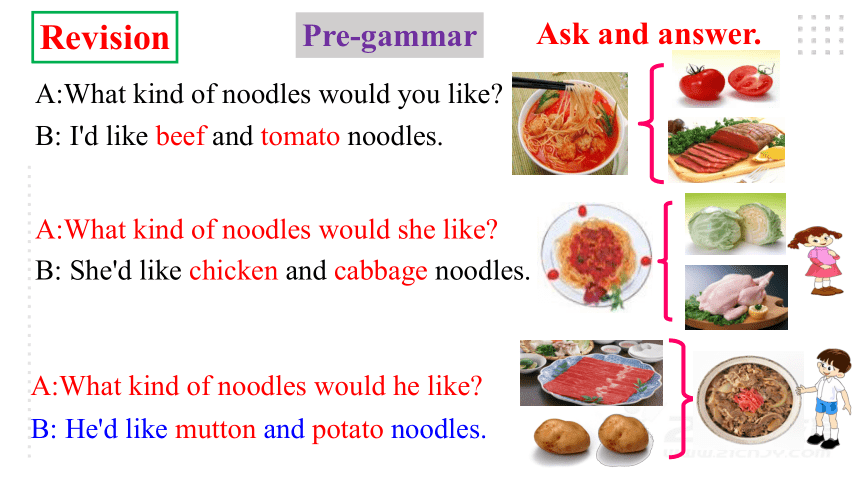

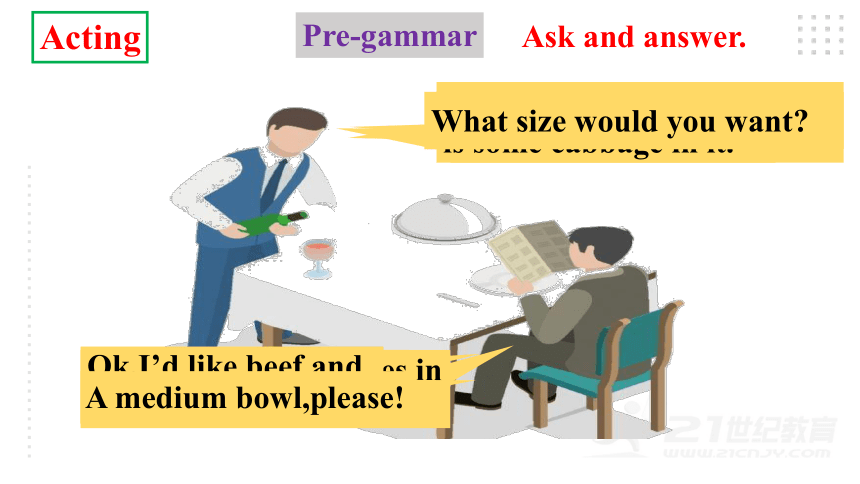
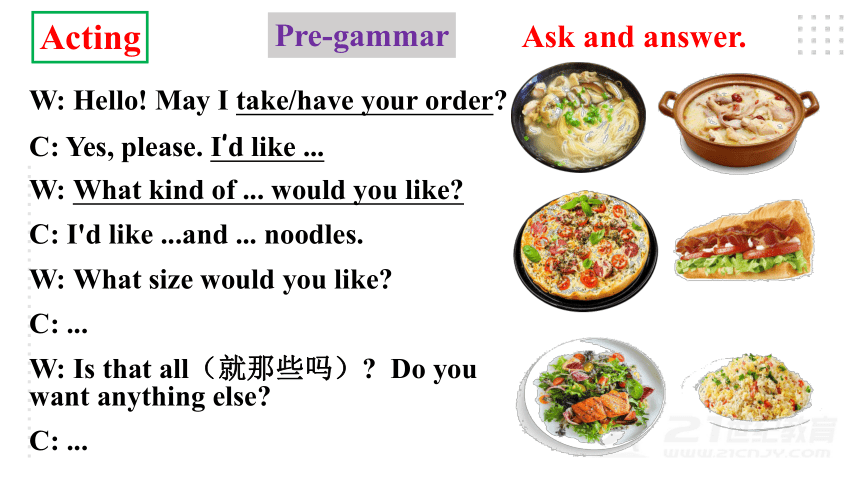
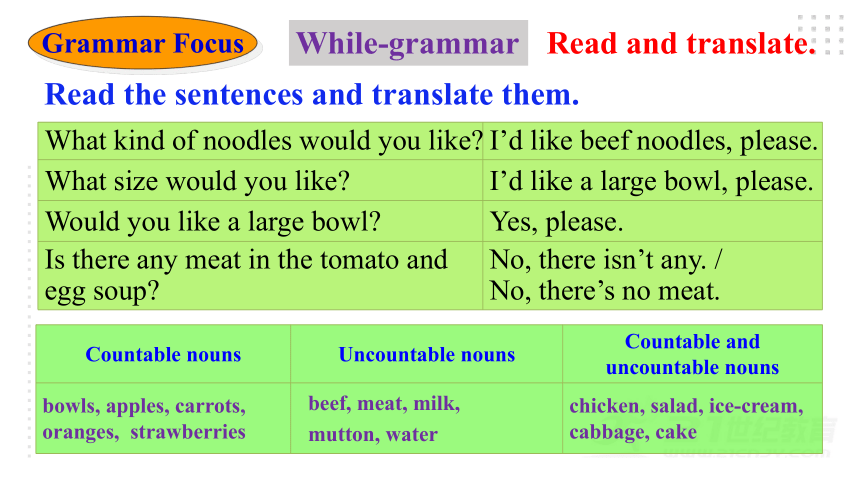

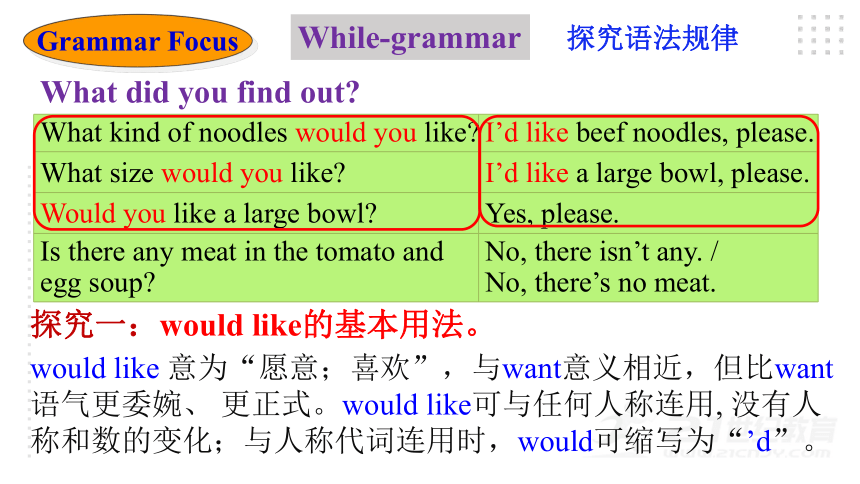
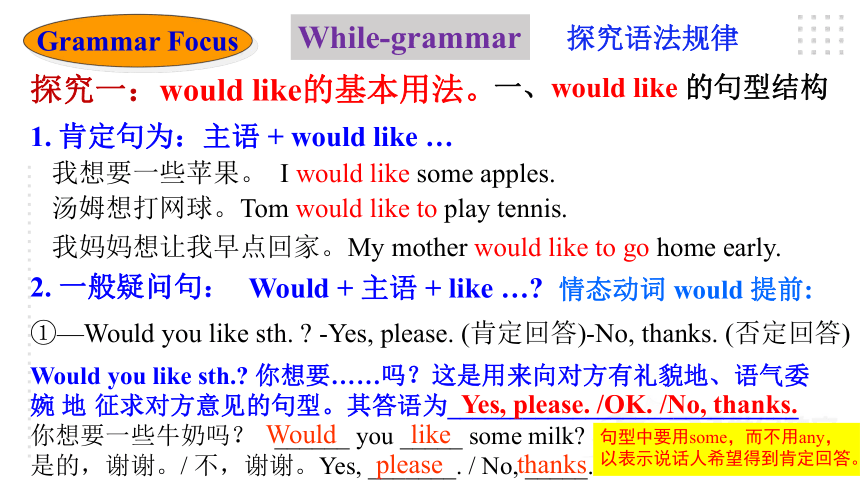
文档简介
(共34张PPT)
人教新目标版 七年级(下)
Unit 10 I’d like some noodles.
Period 2 Section A
Grammar focus-3c
语法课示范课
Presentation
Learning aims
1.掌握下列词汇:meat, what size, what kind of, countable, uncountable
掌握句型:—What kind of noodles would you like
— I'd like beef noodles, please.
—What size would you like —I'd like a large bowl, please.
Is there any meat in the tomato and egg soup.
2. 通过阅读翻译Grammar focus中的句子,能够完成句子,正确说出情态动词would的用法,订餐所用语言及句子结构;能够区别some和any的用法,能够识别可数名词和不可数名词以及用法。
3.通过3a3b3c练习,能够正确使用would like就食物进行询问并点餐,巩固Grammar focus中的语法,说出中国的饮食文化。
Presentation
Revision
Pre-gammar
Look and say.
noodles
mutton
milk
beef
carrots
potatoes
strawberries
rice
What would you like I’d like ….
Presentation
There are three bowls of beef noodles
Who want to eat
What size would you like
small
medium
large
a small bowl
of noodles
a medium bowl
of noodles
a large bowl
of noodles
Revision
Pre-gammar
Look and say.
Presentation
Pre-gammar
Ask and answer.
A:What kind of noodles would you like
A:What kind of noodles would she like
B: I'd like beef and tomato noodles.
B: She'd like chicken and cabbage noodles.
Revision
A:What kind of noodles would he like
B: He'd like mutton and potato noodles.
Presentation
Pre-gammar
Ask and answer.
Revision
A: What kind of noodles would you like B: I’d like …noodles, please.
A: What size bowl of noodles would you like B: I’d like…
egg and tomato
beef and tomato
mutton and cabbage
pork and cabbage
chicken and egg
beef and cabbage
Presentation
Acting
Pre-gammar
Ask and answer.
What would you like
I’d like some noodles.
What kind of nooldes would you like
Are there any tomatoes in beef noodles
Sorry,there aren’t. But there is some cabbage in it.
Ok,I’d like beef and
cabbage noodles.
What size would you want
A medium bowl,please!
Presentation
Acting
Pre-gammar
Ask and answer.
W: Hello! May I take/have your order
C: Yes, please. I’d like ...
W: What kind of ... would you like
C: I'd like ...and ... noodles.
W: What size would you like
C: ...
W: Is that all(就那些吗) Do you want anything else
C: ...
Presentation
While-grammar
Grammar Focus
Read the sentences and translate them.
What kind of noodles would you like I’d like beef noodles, please.
What size would you like I’d like a large bowl, please.
Would you like a large bowl Yes, please.
Is there any meat in the tomato and egg soup No, there isn’t any. /
No, there’s no meat.
Countable nouns Uncountable nouns Countable and uncountable nouns
bowls, apples, carrots, oranges, strawberries beef, meat, milk,
mutton, water chicken, salad, ice-cream, cabbage, cake
Read and translate.
Presentation
Practice
While-grammar
Fill in the blanks according to grammar focus.
1. 你想要什么面条?____ ____ ____ noodles would you like
2. 请给我来牛肉面。_____ _____ beef noodles, please.
3. 你想要什么碗的?_____ _____ would you like
4. 请给我来中碗的。 I’d like a _____ _____ , please.
5. 你想来一个大碗吗?_____ you _____ a large bowl
6. 好的。 _____ , _____ .
7. 在西红柿子鸡蛋汤里有肉吗
____ ____ ____ meat in the tomato and egg soup
8. 不,没有。 _______________________________
What kind of
I’d like
What size
medium bowl
Would like
Yes please
Is there any
No, there isn’t any. /No, there’s no meat.
Read and fill.
Presentation
Grammar Focus
While-grammar
探究语法规律
What did you find out
What kind of noodles would you like I’d like beef noodles, please.
What size would you like I’d like a large bowl, please.
Would you like a large bowl Yes, please.
Is there any meat in the tomato and egg soup No, there isn’t any. /
No, there’s no meat.
探究一:would like的基本用法。
would like 意为“愿意;喜欢”,与want意义相近,但比want语气更委婉、 更正式。would like可与任何人称连用, 没有人称和数的变化;与人称代词连用时,would可缩写为“’d”。
Presentation
Grammar Focus
While-grammar
探究语法规律
探究一:would like的基本用法。
一、would like 的句型结构
1. 肯定句为:主语 + would like …
我想要一些苹果。 I would like some apples.
汤姆想打网球。Tom would like to play tennis.
我妈妈想让我早点回家。My mother would like to go home early.
2. 一般疑问句:
①—Would you like sth. -Yes, please. (肯定回答)-No, thanks. (否定回答)
Would you like sth. 你想要……吗?这是用来向对方有礼貌地、语气委婉 地 征求对方意见的句型。其答语为____________________________
你想要一些牛奶吗? ______ you _____ some milk
是的,谢谢。/ 不,谢谢。Yes, _______. / No, _____.
Yes, please. /OK. /No, thanks.
Would like
please thanks
Would + 主语 + like …
情态动词 would 提前:
句型中要用some,而不用any,以表示说话人希望得到肯定回答。
Presentation
Grammar Focus
While-grammar
探究语法规律
探究一:would like的基本用法。
2. 一般疑问句:
Would + 主语 + like …
②-Would you like to do sth. -Sure, I’d love/like to. (肯定回答)
-Sorry, I’m afraid I can’t./I’d love/like to, but... (否定回答)
【拓展】Would you like to do sth. 你愿意做某事吗?
用来有礼貌地向对方提出建议或邀请的句型。
答语常为“Yes, I’d like to.” / “Sorry, , but I’m too busy…\I’d
love/like to, but…” 。
你愿意和我们一起去划船吗? Would you like to go boating with us
你愿意和我们一起去野营吗?
Would you like to go camping with us Yes, I’d love/like to.
Presentation
Grammar Focus
While-grammar
探究语法规律
探究一:would like的基本用法。
3. 否定句:主语+ would + not + like+其它
He would not like to leave his hometown.他不愿意离开他的家乡。
I would not like the red tea.
They would not like to swim this afternoon.
What kind of noodles would you like
I’d like beef and tomato noodles.
4. 特殊疑问句:特殊疑问词+would +主语+like +其它成分
What size would you like
What would you like
Presentation
Grammar Focus
While-grammar
探究语法规律
探究一:would like的基本用法。
二、would like 的常见句型
1) would like sth. 想要某物。例如:
I would like beef noodles. 我想要牛肉面。
— Would you like a cup of tea — Yes, please. / No, thanks.
2) would like to do sth. 想要做某事。例如:
My friends would like to visit you. 我朋友想去拜访你。
I would like to be a great writer. 我想成为一名伟大的作家。
3) would like sb. to do sth. 想让某人做某事。例如:
Her parents would like her to learn music. 她的父母想让她学音乐。
I’d like you to be more careful when you drive. 我希望你开车时能更加小心。
Presentation
Grammar Focus
While-grammar
探究语法规律
What did you find out
What kind of noodles would you like I’d like beef noodles, please.
What size would you like I’d like a large bowl, please.
Would you like a large bowl Yes, please.
Is there any meat in the tomato and egg soup No, there isn’t any. /
No, there’s no meat.
探究二:some和any的用法区别。
some 常译作“一些”,多用于肯定句,也用在疑问句中,表示期望对方肯定的答复,以示礼貌; any表示“任何”,通常用于否定句和疑问句中。some/any通常接可数名词复数和不可数名词,表示不确定的数量。
Presentation
Grammar Focus
While-grammar
探究语法规律
探究二:some和any的用法区别。
1. some的用法: some意为“一些”,可作形容词和代词。它常修饰可数名
词复数, some books 一些书,some boys 一些男孩,也可修饰不可数名词
some water 一些水,some tea 一些茶叶,some通常用于肯定句,any通常
用于否定句、疑问句。
I can see some books on the desk.
2. any的用法: any意为“任何一些”,它也可修饰可数名词复数或不可
数名词,常用于疑问句和否定句。如:
我没看见茶叶。
你在学校有些朋友吗
He doesn’t have any friends. Do you have any money
I can’t see any tea.
Do you have any friends at school
She didn’t eat any meat for dinner. Are there any stamps in that drawer
Presentation
Grammar Focus
While-grammar
探究语法规律
探究二:some和any的用法区别。
3,但在表示建议,反问,请求的疑问句中,或期望得到肯定回答
时,多用some而不用any。
如:Would you like some coffee 你要不要来点咖啡
How about some fruit juice 来点水果汁如何
4.当any表示“任何的,任一的”的意义,后常接单数可数名词,
起强调作用时,它可以用在肯定句中;
Any student can answer this question.任何学生都可以回答这个问题。
e.g. Any book is OK. I don’t mind.
Presentation
Grammar Focus
While-grammar
探究语法规律
Countable nouns Uncountable nouns Countable and uncountable nouns
bowls, apples, carrots, oranges, strawberries beef, meat, milk,
mutton, water chicken, salad, ice-cream, cabbage, cake
What did you find out
探究三:可数名词和不可数名词的用法。
可数名词: 可以计数的名词称为可数名词。 一般有单数与复数两种形式, 前面可加a, an或数词来修饰。
不可数名词: 不可计数的名词称为不可数名词。没有复数形式, 前面不能用不定冠词a, an, 也不能直接加数词, 但可以跟某些量词短语搭配, 表示数量。如: a glass of water, two cups of tea。
Presentation
Grammar Focus
While-grammar
探究语法规律
探究三:可数名词和不可数名词的用法。
1. 可数名词的用法:有单数和复数之分。如:a box, two boxes。
(1) 其前可直接用不定冠词a/an或具体的数词修饰,表示数量。如:a bowl ,an orange, two potatoes。
(2) 可用定冠词the修饰,表示特指,如:the girl(这个女孩)。
(3)可用some, any, few, a few, many, lots of, a lot of等修饰。
(4)询问数量多少用how many。How many apples would you like
(5)单数可数名词做主语,谓语动词用单数形式(三单形式);复数可数名词
做主语,谓语动词用复数形式(一般现在时用动词原形)。
My father works in a hospital.
His parents work in the same school.
Presentation
Grammar Focus
While-grammar
探究语法规律
探究三:可数名词和不可数名词的用法。
(6)可数名词复数变化规则。
1) 一般情况加s: students, apples, bags, trees, books, brothers?
2) 以s、x、sh、ch结尾的名词加es: glasses, boxes, brushes, matches?
3) 以辅音字母加y结尾的名词, 变y为i,加es: cities, babies, enemies
4) 以f或fe结尾的名词,多数变f或fe为v加 es: wives, knives; 但有些词只加s: roofs, proofs, chiefs?
5) 以o结尾的名词,有些加es: Negroes, heroes, tomatoes, potatoes; 其它加s: radios, zoos, pianos, photos.?
6) 不规则变化: foot→ feet goose→ geese tooth→ teeth child→ children man→ men woman→ women sheep→ sheep deer→ deer mouse→ mice
Presentation
Grammar Focus
While-grammar
探究语法规律
探究三:可数名词和不可数名词的用法。
2. 不可数名词的用法:不可数名词没有复数形式,只有单数形式。
如:beef, mutton, meat, milk。some rice (米饭);a lot of beef (牛肉)。
(1) 其前不能用不定冠词a/an或数词修饰。
(2) 可用定冠词the修饰,表示特指,如:the bread(这块面包)。
(3) 可用some, any, little, a little, much, a lot of, lots of等修饰。
(4)询问量的多少用how much。
(5)不可数名词表示数量的多少时,必须与表示数量的名词连用,即“数词 + 表示数量的名词(可数名词)+ of + 不可数名词”。如:
两玻璃杯果汁 two glasses of juice
三碗米three bowls of rice
Presentation
Grammar Focus
While-grammar
探究语法规律
探究三:可数名词和不可数名词的用法。
2. 不可数名词的用法:
(6) 不可数名词做主语时,谓语动词只能用 单数形式。例如:
在碗里有一些羊肉汤。There is some mutton soup in the bowl.
【拓展】不可数名词的量可以用 “a/an/基数词+表示量的名词 + of + 不可数名词” 表示,这些表示量的名词有单复数形式的变化。这一结构作主语时,谓语动词的单复数形式要与表示量的名词保持一致。
There is a bottle of juice on the table. 桌子上有一瓶果汁。(谓语动词is与a bottle保持一致)
There are three bowls of mutton soup on the table. 桌子上有三碗羊肉汤。(谓语动词are与three bowls保持一致)
Presentation
Grammar Focus
While-grammar
探究语法规律
探究三:可数名词和不可数名词的用法。
3. 既可数又不可数名词的用法:
有些名词既可以作可数名词,也可以作不可数名词,要根据句子的具体
情景来判断。来判断下列句子中chicken和cabbage的用法。
a. They keep a chicken in the back yard.
b. Would you like some chicken
c. There are three cabbages in the kitchen.
d. There is no cabbage in the soup.
chicken作“小鸡”讲时是可数名词。
chicken作“鸡肉”讲时是不可数名词。
cabbage作“卷心菜”讲时是可数名词。
cabbage作“卷心菜(的物质)”讲时是不可数名词。
4.复合名词变复数: 以不可数名词结尾的复合名词无复数形式,如: homework, housework.以man或woman为前缀的复数名词变复数, 前后两个名词都复数, 如:a man teacher →some men teachers, a woman doctor →some women doctors. 比较:an apple tree → some apple trees a boy friend →some boy friends tomato and egg noodles
Presentation
Practice
Post-grammar
Look and fill.
3a
Complete the conversation below.
1. May I have your order ___
2. What kind of noodles would
you like ___
3. We have beef, chicken, mutton,
cabbage, potato, tomato... ___
4. Yes, there are some carrots. ___
5. Sure. What size would you like ___
6. We have large, medium and small
bowls. ___
d
a. What kind of noodles do you have
b. Oh, a medium bowl, please.
c. OK, I’d like the mutton noodles
then.
d. I’d like some noodles, please.
e. What sizes do you have
f. Are there any vegetables in the
mutton noodles
a
f
c
e
b
方法指导:
1. 先通读一遍问句与答语部分的选项,整体把握对话的大意,明确对话中顾客想要吃的食物。
2. 开头的问答句,已给出答案了,因此应按说话的逻辑顺序,顺藤摸瓜。比如:第2句,服务员问“想吃什么面条”时,顾客应想知道有何种类型的面条,故用a句来答。第3问句中,服务员介绍了有何类型的面条,并在第4句中,回答了一句Yes,可知顾客仍在询问,故可知应用f作答。对第4句的答语应是选择一种面条作答,故选c。接下来对面条的大小碗型号进行问答就较易选择了。
Presentation
Practice
Post-grammar
Look and write.
3b
Write questions and answers using the words in brackets.
1._________________________________________
_________________________________________
2._________________________________________ (size)
_________________________________________ (medium)
3._________________________________________ (any/cabbage/beef noodles)
_________________________________________ (no)
What kind of noodles would you like (kind)
I’d like chicken and beef noodles with tomatoes.
What size would you like
I’d like a medium bowl, please.
Is there any cabbage in the beef noodles
No, there isn’t any.
方法指导
1. 由例句可知, 本题要求同学们根据括号中的提示词, 分别造三个问句与三个答语。
2. 根据括号中的提示词可知, 第二个问句应是询问想要多大碗的面条, 回答是中碗的面条。
3. 根据答语中提示词no可知, 第三个问句应是一般疑问句, 作一个否定的回答语。
Presentation
Practice
Post-grammar
Look and write.
3c
Work in small groups. Who would like the food below Write their names on the cards above the food.
Anna, Bob, Tom and Mary are going to have lunch. They enjoy different kinds of food. Now, there are four kinds of food in front of them, which one will each person eat Let’s ask them.
Presentation
3c
Work in small groups. Who would like the food below Write their names on the cards above the food.
Practice
Post-grammar
Ask and answer.
A: Anna, what would you like to eat
B: I’d like beef noodles with carrots.
A: Bob, what would you like to eat
B: I’d like the potato salad.
A: Tom, what would you like to eat, hamburger or tomato and egg rice B: Tomato and egg rice.
A: Mary, Would you like the hamburger
B: Yes, please.
Presentation
Writing
Post-grammar
Look and write.
3c
Work in small groups. Who would like the food below Write their names on the cards above the food.
Anna
Grace
Linda
Bob
Presentation
Class test
Post-grammar
一、用所给词的适当形式填空
1. I’d like beef ___ (noodle).
2. What would you like (have)for breakfast
3. I want to buy some juice ___ (drink).
4. There (be)lots of meat in the ice box.
5. We have large, medium and small (bowl).
noodles
to have
to drink
is
bowls
Presentation
Class test
Post-grammar
二、完成句子
1. 你喜欢什么样的流行音乐
pop music do you like
2. 我想要带西红柿的鸡蛋面。
I’d like noodles tomatoes.
3. 汤里没有肉。There is in the soup.
4. 玛丽不喜欢鸡肉, 但却养了很多小鸡。
Mary doesn’t like , but she has many .
5. 我想给妈妈买些鲜花。
I’d like some flowers for my mother.
What kind of
egg
with
no meat
chicken
chickens
to buy
Presentation
Homework
Compulsory homework(必做作业)
1. 背诵并默写Section A Grammar Focue中的句子。
2. 预习Section B 1a-1d, 默写P58单词。
Optional homework(选做作业)
1. Make a dialogue.
2. Read a short
passage and answer
the questions.
May I take your order?\Can I help you
Here's the menu.
What kind of …would you like
What size would you like
Is that all
Wait a minute, please.
I'd like…
I'd like a table for two.
How much is it, please
Yes, that;s right.
https://www.21cnjy.com/help/help_extract.php
人教新目标版 七年级(下)
Unit 10 I’d like some noodles.
Period 2 Section A
Grammar focus-3c
语法课示范课
Presentation
Learning aims
1.掌握下列词汇:meat, what size, what kind of, countable, uncountable
掌握句型:—What kind of noodles would you like
— I'd like beef noodles, please.
—What size would you like —I'd like a large bowl, please.
Is there any meat in the tomato and egg soup.
2. 通过阅读翻译Grammar focus中的句子,能够完成句子,正确说出情态动词would的用法,订餐所用语言及句子结构;能够区别some和any的用法,能够识别可数名词和不可数名词以及用法。
3.通过3a3b3c练习,能够正确使用would like就食物进行询问并点餐,巩固Grammar focus中的语法,说出中国的饮食文化。
Presentation
Revision
Pre-gammar
Look and say.
noodles
mutton
milk
beef
carrots
potatoes
strawberries
rice
What would you like I’d like ….
Presentation
There are three bowls of beef noodles
Who want to eat
What size would you like
small
medium
large
a small bowl
of noodles
a medium bowl
of noodles
a large bowl
of noodles
Revision
Pre-gammar
Look and say.
Presentation
Pre-gammar
Ask and answer.
A:What kind of noodles would you like
A:What kind of noodles would she like
B: I'd like beef and tomato noodles.
B: She'd like chicken and cabbage noodles.
Revision
A:What kind of noodles would he like
B: He'd like mutton and potato noodles.
Presentation
Pre-gammar
Ask and answer.
Revision
A: What kind of noodles would you like B: I’d like …noodles, please.
A: What size bowl of noodles would you like B: I’d like…
egg and tomato
beef and tomato
mutton and cabbage
pork and cabbage
chicken and egg
beef and cabbage
Presentation
Acting
Pre-gammar
Ask and answer.
What would you like
I’d like some noodles.
What kind of nooldes would you like
Are there any tomatoes in beef noodles
Sorry,there aren’t. But there is some cabbage in it.
Ok,I’d like beef and
cabbage noodles.
What size would you want
A medium bowl,please!
Presentation
Acting
Pre-gammar
Ask and answer.
W: Hello! May I take/have your order
C: Yes, please. I’d like ...
W: What kind of ... would you like
C: I'd like ...and ... noodles.
W: What size would you like
C: ...
W: Is that all(就那些吗) Do you want anything else
C: ...
Presentation
While-grammar
Grammar Focus
Read the sentences and translate them.
What kind of noodles would you like I’d like beef noodles, please.
What size would you like I’d like a large bowl, please.
Would you like a large bowl Yes, please.
Is there any meat in the tomato and egg soup No, there isn’t any. /
No, there’s no meat.
Countable nouns Uncountable nouns Countable and uncountable nouns
bowls, apples, carrots, oranges, strawberries beef, meat, milk,
mutton, water chicken, salad, ice-cream, cabbage, cake
Read and translate.
Presentation
Practice
While-grammar
Fill in the blanks according to grammar focus.
1. 你想要什么面条?____ ____ ____ noodles would you like
2. 请给我来牛肉面。_____ _____ beef noodles, please.
3. 你想要什么碗的?_____ _____ would you like
4. 请给我来中碗的。 I’d like a _____ _____ , please.
5. 你想来一个大碗吗?_____ you _____ a large bowl
6. 好的。 _____ , _____ .
7. 在西红柿子鸡蛋汤里有肉吗
____ ____ ____ meat in the tomato and egg soup
8. 不,没有。 _______________________________
What kind of
I’d like
What size
medium bowl
Would like
Yes please
Is there any
No, there isn’t any. /No, there’s no meat.
Read and fill.
Presentation
Grammar Focus
While-grammar
探究语法规律
What did you find out
What kind of noodles would you like I’d like beef noodles, please.
What size would you like I’d like a large bowl, please.
Would you like a large bowl Yes, please.
Is there any meat in the tomato and egg soup No, there isn’t any. /
No, there’s no meat.
探究一:would like的基本用法。
would like 意为“愿意;喜欢”,与want意义相近,但比want语气更委婉、 更正式。would like可与任何人称连用, 没有人称和数的变化;与人称代词连用时,would可缩写为“’d”。
Presentation
Grammar Focus
While-grammar
探究语法规律
探究一:would like的基本用法。
一、would like 的句型结构
1. 肯定句为:主语 + would like …
我想要一些苹果。 I would like some apples.
汤姆想打网球。Tom would like to play tennis.
我妈妈想让我早点回家。My mother would like to go home early.
2. 一般疑问句:
①—Would you like sth. -Yes, please. (肯定回答)-No, thanks. (否定回答)
Would you like sth. 你想要……吗?这是用来向对方有礼貌地、语气委婉 地 征求对方意见的句型。其答语为____________________________
你想要一些牛奶吗? ______ you _____ some milk
是的,谢谢。/ 不,谢谢。Yes, _______. / No, _____.
Yes, please. /OK. /No, thanks.
Would like
please thanks
Would + 主语 + like …
情态动词 would 提前:
句型中要用some,而不用any,以表示说话人希望得到肯定回答。
Presentation
Grammar Focus
While-grammar
探究语法规律
探究一:would like的基本用法。
2. 一般疑问句:
Would + 主语 + like …
②-Would you like to do sth. -Sure, I’d love/like to. (肯定回答)
-Sorry, I’m afraid I can’t./I’d love/like to, but... (否定回答)
【拓展】Would you like to do sth. 你愿意做某事吗?
用来有礼貌地向对方提出建议或邀请的句型。
答语常为“Yes, I’d like to.” / “Sorry, , but I’m too busy…\I’d
love/like to, but…” 。
你愿意和我们一起去划船吗? Would you like to go boating with us
你愿意和我们一起去野营吗?
Would you like to go camping with us Yes, I’d love/like to.
Presentation
Grammar Focus
While-grammar
探究语法规律
探究一:would like的基本用法。
3. 否定句:主语+ would + not + like+其它
He would not like to leave his hometown.他不愿意离开他的家乡。
I would not like the red tea.
They would not like to swim this afternoon.
What kind of noodles would you like
I’d like beef and tomato noodles.
4. 特殊疑问句:特殊疑问词+would +主语+like +其它成分
What size would you like
What would you like
Presentation
Grammar Focus
While-grammar
探究语法规律
探究一:would like的基本用法。
二、would like 的常见句型
1) would like sth. 想要某物。例如:
I would like beef noodles. 我想要牛肉面。
— Would you like a cup of tea — Yes, please. / No, thanks.
2) would like to do sth. 想要做某事。例如:
My friends would like to visit you. 我朋友想去拜访你。
I would like to be a great writer. 我想成为一名伟大的作家。
3) would like sb. to do sth. 想让某人做某事。例如:
Her parents would like her to learn music. 她的父母想让她学音乐。
I’d like you to be more careful when you drive. 我希望你开车时能更加小心。
Presentation
Grammar Focus
While-grammar
探究语法规律
What did you find out
What kind of noodles would you like I’d like beef noodles, please.
What size would you like I’d like a large bowl, please.
Would you like a large bowl Yes, please.
Is there any meat in the tomato and egg soup No, there isn’t any. /
No, there’s no meat.
探究二:some和any的用法区别。
some 常译作“一些”,多用于肯定句,也用在疑问句中,表示期望对方肯定的答复,以示礼貌; any表示“任何”,通常用于否定句和疑问句中。some/any通常接可数名词复数和不可数名词,表示不确定的数量。
Presentation
Grammar Focus
While-grammar
探究语法规律
探究二:some和any的用法区别。
1. some的用法: some意为“一些”,可作形容词和代词。它常修饰可数名
词复数, some books 一些书,some boys 一些男孩,也可修饰不可数名词
some water 一些水,some tea 一些茶叶,some通常用于肯定句,any通常
用于否定句、疑问句。
I can see some books on the desk.
2. any的用法: any意为“任何一些”,它也可修饰可数名词复数或不可
数名词,常用于疑问句和否定句。如:
我没看见茶叶。
你在学校有些朋友吗
He doesn’t have any friends. Do you have any money
I can’t see any tea.
Do you have any friends at school
She didn’t eat any meat for dinner. Are there any stamps in that drawer
Presentation
Grammar Focus
While-grammar
探究语法规律
探究二:some和any的用法区别。
3,但在表示建议,反问,请求的疑问句中,或期望得到肯定回答
时,多用some而不用any。
如:Would you like some coffee 你要不要来点咖啡
How about some fruit juice 来点水果汁如何
4.当any表示“任何的,任一的”的意义,后常接单数可数名词,
起强调作用时,它可以用在肯定句中;
Any student can answer this question.任何学生都可以回答这个问题。
e.g. Any book is OK. I don’t mind.
Presentation
Grammar Focus
While-grammar
探究语法规律
Countable nouns Uncountable nouns Countable and uncountable nouns
bowls, apples, carrots, oranges, strawberries beef, meat, milk,
mutton, water chicken, salad, ice-cream, cabbage, cake
What did you find out
探究三:可数名词和不可数名词的用法。
可数名词: 可以计数的名词称为可数名词。 一般有单数与复数两种形式, 前面可加a, an或数词来修饰。
不可数名词: 不可计数的名词称为不可数名词。没有复数形式, 前面不能用不定冠词a, an, 也不能直接加数词, 但可以跟某些量词短语搭配, 表示数量。如: a glass of water, two cups of tea。
Presentation
Grammar Focus
While-grammar
探究语法规律
探究三:可数名词和不可数名词的用法。
1. 可数名词的用法:有单数和复数之分。如:a box, two boxes。
(1) 其前可直接用不定冠词a/an或具体的数词修饰,表示数量。如:a bowl ,an orange, two potatoes。
(2) 可用定冠词the修饰,表示特指,如:the girl(这个女孩)。
(3)可用some, any, few, a few, many, lots of, a lot of等修饰。
(4)询问数量多少用how many。How many apples would you like
(5)单数可数名词做主语,谓语动词用单数形式(三单形式);复数可数名词
做主语,谓语动词用复数形式(一般现在时用动词原形)。
My father works in a hospital.
His parents work in the same school.
Presentation
Grammar Focus
While-grammar
探究语法规律
探究三:可数名词和不可数名词的用法。
(6)可数名词复数变化规则。
1) 一般情况加s: students, apples, bags, trees, books, brothers?
2) 以s、x、sh、ch结尾的名词加es: glasses, boxes, brushes, matches?
3) 以辅音字母加y结尾的名词, 变y为i,加es: cities, babies, enemies
4) 以f或fe结尾的名词,多数变f或fe为v加 es: wives, knives; 但有些词只加s: roofs, proofs, chiefs?
5) 以o结尾的名词,有些加es: Negroes, heroes, tomatoes, potatoes; 其它加s: radios, zoos, pianos, photos.?
6) 不规则变化: foot→ feet goose→ geese tooth→ teeth child→ children man→ men woman→ women sheep→ sheep deer→ deer mouse→ mice
Presentation
Grammar Focus
While-grammar
探究语法规律
探究三:可数名词和不可数名词的用法。
2. 不可数名词的用法:不可数名词没有复数形式,只有单数形式。
如:beef, mutton, meat, milk。some rice (米饭);a lot of beef (牛肉)。
(1) 其前不能用不定冠词a/an或数词修饰。
(2) 可用定冠词the修饰,表示特指,如:the bread(这块面包)。
(3) 可用some, any, little, a little, much, a lot of, lots of等修饰。
(4)询问量的多少用how much。
(5)不可数名词表示数量的多少时,必须与表示数量的名词连用,即“数词 + 表示数量的名词(可数名词)+ of + 不可数名词”。如:
两玻璃杯果汁 two glasses of juice
三碗米three bowls of rice
Presentation
Grammar Focus
While-grammar
探究语法规律
探究三:可数名词和不可数名词的用法。
2. 不可数名词的用法:
(6) 不可数名词做主语时,谓语动词只能用 单数形式。例如:
在碗里有一些羊肉汤。There is some mutton soup in the bowl.
【拓展】不可数名词的量可以用 “a/an/基数词+表示量的名词 + of + 不可数名词” 表示,这些表示量的名词有单复数形式的变化。这一结构作主语时,谓语动词的单复数形式要与表示量的名词保持一致。
There is a bottle of juice on the table. 桌子上有一瓶果汁。(谓语动词is与a bottle保持一致)
There are three bowls of mutton soup on the table. 桌子上有三碗羊肉汤。(谓语动词are与three bowls保持一致)
Presentation
Grammar Focus
While-grammar
探究语法规律
探究三:可数名词和不可数名词的用法。
3. 既可数又不可数名词的用法:
有些名词既可以作可数名词,也可以作不可数名词,要根据句子的具体
情景来判断。来判断下列句子中chicken和cabbage的用法。
a. They keep a chicken in the back yard.
b. Would you like some chicken
c. There are three cabbages in the kitchen.
d. There is no cabbage in the soup.
chicken作“小鸡”讲时是可数名词。
chicken作“鸡肉”讲时是不可数名词。
cabbage作“卷心菜”讲时是可数名词。
cabbage作“卷心菜(的物质)”讲时是不可数名词。
4.复合名词变复数: 以不可数名词结尾的复合名词无复数形式,如: homework, housework.以man或woman为前缀的复数名词变复数, 前后两个名词都复数, 如:a man teacher →some men teachers, a woman doctor →some women doctors. 比较:an apple tree → some apple trees a boy friend →some boy friends tomato and egg noodles
Presentation
Practice
Post-grammar
Look and fill.
3a
Complete the conversation below.
1. May I have your order ___
2. What kind of noodles would
you like ___
3. We have beef, chicken, mutton,
cabbage, potato, tomato... ___
4. Yes, there are some carrots. ___
5. Sure. What size would you like ___
6. We have large, medium and small
bowls. ___
d
a. What kind of noodles do you have
b. Oh, a medium bowl, please.
c. OK, I’d like the mutton noodles
then.
d. I’d like some noodles, please.
e. What sizes do you have
f. Are there any vegetables in the
mutton noodles
a
f
c
e
b
方法指导:
1. 先通读一遍问句与答语部分的选项,整体把握对话的大意,明确对话中顾客想要吃的食物。
2. 开头的问答句,已给出答案了,因此应按说话的逻辑顺序,顺藤摸瓜。比如:第2句,服务员问“想吃什么面条”时,顾客应想知道有何种类型的面条,故用a句来答。第3问句中,服务员介绍了有何类型的面条,并在第4句中,回答了一句Yes,可知顾客仍在询问,故可知应用f作答。对第4句的答语应是选择一种面条作答,故选c。接下来对面条的大小碗型号进行问答就较易选择了。
Presentation
Practice
Post-grammar
Look and write.
3b
Write questions and answers using the words in brackets.
1._________________________________________
_________________________________________
2._________________________________________ (size)
_________________________________________ (medium)
3._________________________________________ (any/cabbage/beef noodles)
_________________________________________ (no)
What kind of noodles would you like (kind)
I’d like chicken and beef noodles with tomatoes.
What size would you like
I’d like a medium bowl, please.
Is there any cabbage in the beef noodles
No, there isn’t any.
方法指导
1. 由例句可知, 本题要求同学们根据括号中的提示词, 分别造三个问句与三个答语。
2. 根据括号中的提示词可知, 第二个问句应是询问想要多大碗的面条, 回答是中碗的面条。
3. 根据答语中提示词no可知, 第三个问句应是一般疑问句, 作一个否定的回答语。
Presentation
Practice
Post-grammar
Look and write.
3c
Work in small groups. Who would like the food below Write their names on the cards above the food.
Anna, Bob, Tom and Mary are going to have lunch. They enjoy different kinds of food. Now, there are four kinds of food in front of them, which one will each person eat Let’s ask them.
Presentation
3c
Work in small groups. Who would like the food below Write their names on the cards above the food.
Practice
Post-grammar
Ask and answer.
A: Anna, what would you like to eat
B: I’d like beef noodles with carrots.
A: Bob, what would you like to eat
B: I’d like the potato salad.
A: Tom, what would you like to eat, hamburger or tomato and egg rice B: Tomato and egg rice.
A: Mary, Would you like the hamburger
B: Yes, please.
Presentation
Writing
Post-grammar
Look and write.
3c
Work in small groups. Who would like the food below Write their names on the cards above the food.
Anna
Grace
Linda
Bob
Presentation
Class test
Post-grammar
一、用所给词的适当形式填空
1. I’d like beef ___ (noodle).
2. What would you like (have)for breakfast
3. I want to buy some juice ___ (drink).
4. There (be)lots of meat in the ice box.
5. We have large, medium and small (bowl).
noodles
to have
to drink
is
bowls
Presentation
Class test
Post-grammar
二、完成句子
1. 你喜欢什么样的流行音乐
pop music do you like
2. 我想要带西红柿的鸡蛋面。
I’d like noodles tomatoes.
3. 汤里没有肉。There is in the soup.
4. 玛丽不喜欢鸡肉, 但却养了很多小鸡。
Mary doesn’t like , but she has many .
5. 我想给妈妈买些鲜花。
I’d like some flowers for my mother.
What kind of
egg
with
no meat
chicken
chickens
to buy
Presentation
Homework
Compulsory homework(必做作业)
1. 背诵并默写Section A Grammar Focue中的句子。
2. 预习Section B 1a-1d, 默写P58单词。
Optional homework(选做作业)
1. Make a dialogue.
2. Read a short
passage and answer
the questions.
May I take your order?\Can I help you
Here's the menu.
What kind of …would you like
What size would you like
Is that all
Wait a minute, please.
I'd like…
I'd like a table for two.
How much is it, please
Yes, that;s right.
https://www.21cnjy.com/help/help_extract.php
同课章节目录
- Unit 1 Can you play the guitar?
- Section A
- Section B
- Unit 2 What time do you go to school?
- Section A
- Section B
- Unit 3 How do you get to school?
- Section A
- Section B
- Unit 4 Don't eat in class.
- Section A
- Section B
- Unit 5 Why do you like pandas?
- Section A
- Section B
- Unit 6 I'm watching TV.
- Section A
- Section B
- Review of Units 1-6
- Unit 7 It's raining!
- Section A
- Section B
- Unit 8 Is there a post office near here?
- Section A
- Section B
- Unit 9 What does he look like?
- Section A
- Section B
- Unit 10 I'd like some noodles.
- Section A
- Section B
- Unit 11 How was your school trip?
- Section A
- Section B
- Unit 12 What did you do last weekend?
- Section A
- Section B
